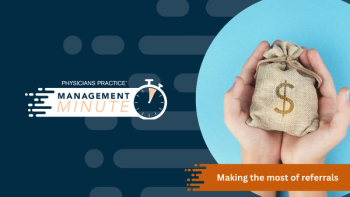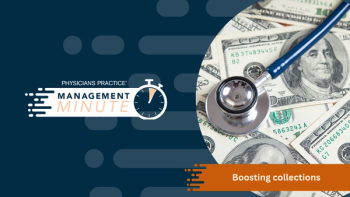
Improving Charge Capture
Practices lose thousands yearly as a result of poor charge capture. Learn to fix it.
It may seem simple to ensure that physicians bill for each of the services they render. Yet practices lose thousands yearly as a result of poor charge capture -- and sometimes they don't even realize it's missing.
Even John Hajjar, MD, who was pretty sure his 11-physician urology group was missing some charges, was surprised by the results of a study he conducted to analyze exactly how much was lost. He found that about 20 percent of inpatient services performed by doctors in his seven-office practice in New Jersey were never billed. Physicians were supposed to record what they did in the hospital on slips of paper and hand them to the billing team, but the slips often got lost or the physicians forgot some services.
Similarly, 35 percent of urinalyses performed by the group, Urology Specialty Care and Surgicare Surgical Associates, never made it onto an encounter form and so were never billed. Even though payment for each urinalysis is small -- only $1.50 to $2 -- the total lost for 11 physicians adds up to $20,000 to $30,000 a year. Worse, even when services were reported on encounter forms, more than 3 percent of the encounter forms themselves were getting lost. That's 3 percent of possible collections that were never even billed.
Hajjar was so frustrated he spent a portion of his own savings to start a company, MDVision, which produces software to help physicians keep up with charge capture. Not many physicians would go as far as to start a new career; but every office should be aware that it is losing money when charge capture goes astray.
Information is money
So how can your practice improve? One low-tech solution demands only a new and improved paper-based system. Many practices ask physicians to make a note of what needs to be billed -- but the notes end up on scrap paper that gets lost in lab coat pockets and washing machines -- or they are simply indecipherable.
Instead, have formal charge capture forms printed. "Make [the form] no bigger than a 3x5 card [so it fits in a physician's pocket], and pad it. Use a little heavier bond so it's durable," suggests Domonic Hammes, partner and consultant for Doctors Financial Health Advisors in La Mesa, Calif. A heavyweight form is harder to forget and harder to lose, he says.
Also, make sure to get all the information the billers will need. A form that merely asks for the patient's name and a diagnosis code isn't always enough. Lucien Roberts, administrator of Neurological Associates in Richmond, Va., has developed a charge capture form that goes beyond the usual. The 13 physicians in the practice, who visit seven different hospitals -- a charge capture nightmare -- are asked to provide the following, in addition to the patient's name and diagnosis code:
- A secondary identifier, such as the patient's date of birth or Social Security number.
- A CPT code. The form includes a grid so that physicians can pick the right one.
- The time and date of service. At least one of Neurological Associates' payers will reimburse more for after-hours services. Roberts thinks it's worth tracking the number of after-hour visits for other payers, too. Come renewal time, he is able to show hard numbers on how the group's physicians went above and beyond and should be properly compensated. "If plumbers get paid for after-hours, why shouldn't doctors?" he asks. "It's time you never get back."
- The name of the referring physician. Using that information sometimes means the billing staff can bill the visit as a higher-paying consult. Roberts estimates that 68 percent of the practice's hospital visits are consults.
- The patient's location, such as a hospital room number.
- Coding review checkbox. This allows the physician to choose to have a certified coder review his coding before the service is billed. The physician can simply check a box on the form.
- Information on any extra services provided. The form includes space for physicians to document other billable activities, like EKGs or Dopplers.
Roberts' goal is to get all the information he needs to bill correctly the first time. Review your forms with a mind toward ensuring that physicians capture all the information billers will need to know.
Record and report
Of course, the greatest form in the world won't help unless the physicians hand them in. To some extent, charge capture "is really about the discipline of the physician," Hammes acknowledges. But even the most undisciplined physician can improve with a little support.
Have your billing staff call the hospital each morning to ask about admissions -- or, better yet, set up live computer access to the hospital's records. Staff can then make sure they have information on any newly admitted patients.
Internally, try numbering encounter sheets. At the end of the day, have staff make sure there is an encounter form for every patient on the schedule.
"The billers have to be proactive," Hammes says. "Physicians are mostly thinking about medicine, not about getting paid, but I've never heard of a physician getting mad at a biller for getting reimbursed."
Another tip: don't batch record-keeping. Instead of recording a visit as soon as it's done or even stopping to make a note after every few visits, many physicians wait until the end of the week. This is a mistake. The physician is likely to forget a few things and be uncertain of others. For example, "physicians who batch record-keeping tend to downcode because a week later they can't separate the patients enough to remember with confidence if that was a level one or a level two," Roberts says.
And even when physicians remember correctly what they did, all that brain-wracking is time-consuming.
Not only that, if a physician loses a week's worth of service notes or forgets to hand them in, the practice has lost much more than if he simply forgot to hand in a day's worth of charges. "If you're doing a weekly sheet and you lose it, you've lost a week. I've seen practices lose weeks worth of billing," Hammes says.
The new way
If carrying around a pad of forms and filling them out frequently just doesn't appeal to you, perhaps one of the new, handheld computer solutions might. Many software companies have created programs physicians can run on portable devices such as a Palm or Blackberry. A simple Web search for "charge capture" will pull up many such vendors.
Using a handheld device, physicians can record charges on the run, and then download the data directly into their practice's billing software. According to a survey by the American College of Physicians-American Society of Internal Medicine (ACP-ASIM), 47 percent of physicians already are using handheld computers for one purpose or another, and 67 percent of ACP-ASIM members will be using them by the end of 2002. It only makes sense to take the devices along while on call.
Hajjar is betting on the transition. He's sure his company's Palm-based product, PracticeValue Charge Capture, which sells for $499, will make money for most practices. If a practice has inefficient charge capture now, he says the product can boost success by 30 to 40 percent. Even an efficient practice can improve by 5 to 10 percent, he adds. Jonathan Romanowsky, director of product management for Redwood Shores, Calif.-based Advance PCS, which has a charge capture tool in beta-testing, agrees that a digitized capture can help eliminate lost papers and illegible scrawl while adding convenience.
But not everyone loves the idea, though. For one, while adoption is high, some physicians are unaccustomed to handheld technology. "Either the doctor will do it or they won't," Hammes observes. "You can't take a group of 10 doctors and hand them PDAs [personal digital assistants] and tell them to go do it. Half of them won't."
Also, some machines and programs may be better than others. Chris Ponder, director of technical services for e/MD2 in Houston, loves that his charge capture program runs on Hewlett-Packard's Jornada, which has a wider screen than a Palm or Blackberry and a built-in keyboard for easy input. However, some physicians will be comfortable with a thumb-based keying system, or will prefer using "graffiti" -- a means of writing using a pencil-like stylus -- to input data.
Even the nicest keyboard, though, won't be able to beat the ability to automatically import and export patient information to and from the practice's computer system. Handheld charge capture systems are most efficient when they integrate easily with a practice's existing software.
Ultimately, what matters more than fancy software or a thick pad of forms is recognizing how important charge capture is and how bad it can get if not done thoroughly. Seemingly small missing dollars add up. However you address the problem, you should make the effort -- whatever form that takes -- to get paid for all you do.
Pamela Moore, senior editor of practice management for Physicians Practice, can be reached at
This article originally appeared in the November/December 2002 issue of Physicians Practice.
Newsletter
Optimize your practice with the Physicians Practice newsletter, offering management pearls, leadership tips, and business strategies tailored for practice administrators and physicians of any specialty.














